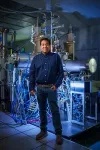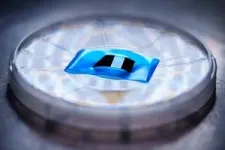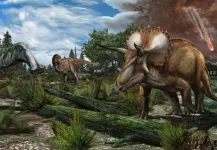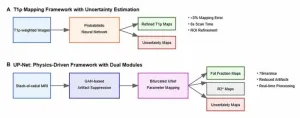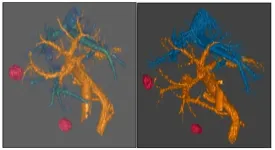(Press-News.org) ALBUQUERQUE, N.M. — Sandia National Laboratories is helping a tech company test a bright new idea for cooling computers.
Minnesota-based startup Maxwell Labs has entered into a cooperative research and development agreement with Sandia and the University of New Mexico to demonstrate laser-based photonic cooling for computer chips. The company is pioneering the new technology to regulate the temperature of chips, significantly lower the power consumption and increase the efficiency of conventional air and water-based systems.
“About 30 to 40 percent of the energy data centers use is spent on cooling,” said Raktim Sarma, the lead Sandia physicist on the project. He added that in some communities, the amount of water needed can strain local resources.
Maxwell’s experimental microchip components could bring relief to the data center industry, where energy costs have become a growing concern.
“A successful project will not only address the immediate need for energy savings but also pave the way for processors to operate at performance levels that were previously thought impossible,” Maxwell Co-Founder and Chief Growth Officer Mike Karpe said.
Data centers are where servers, typically thousands of them, process the emails, web searches and doom scrolls that connect the internet. Companies may also own private data centers for activities that need significant computing power, such as training artificial intelligence. All these activities generate heat, so data centers need extensive cooling systems to prevent servers from overheating.
Many researchers, including Sarma, have been studying photonic technologies — devices that harness light to perform useful work — for various applications, including data processing, communications and national security. Compared to electronics, photonics can be faster and more energy efficient.
But Sarma and his team believe this is the first time anyone has tried using photonics to chill computers.
Enter the laser
Although lasers are better known for heating things up, such as in laser welding, engraving and 3D printing, they can also cool under specific conditions. This occurs when a particular light frequency is matched with a very small, very pure target of a specific element. In some quantum computers, for example, lasers help hold individual atoms at super-cold temperatures.
While Sarma cautioned a laser system cannot cool an entire house or any bulk materials, he said it might work for computer chips like GPUs if the cooling light can be focused on small, localized hot spots.
“We really only have to cool down spots that are on the order of hundreds of microns,” about the size of a speck of dust.
Maxwell CEO Jacob Balma says his company aims to do just this. The idea is to use a photonic cold plate to either replace or complement water and air based cooling systems, which also allows for the resulting extracted heat in the form of light to be recycled and turned back into electricity.
In some current systems, cold water flows through microscopic channels in copper cold plates laid over a chip to soak up heat.
The Maxwell cold plate would be a light-based variation, designed with materials and microscopic features roughly the size of a virus — about a thousand times smaller than the thickness of a human hair — that channel cooling laser light to localized hot spots.
Balma said his company’s models indicate a laser-based cooling system can keep chips colder than water-based systems, explaining, “This will enable novel energy-recovery paradigms not possible with traditional cooling technology.”
If the models prove accurate, the new way of cooling could allow chips to operate harder without overheating, improving their overall performance and power efficiency simultaneously.
“The unique capability of light to target and control localized heating spatially and at optical timescales for these devices unlocks thermal design constraints that are so fundamental to chip design that it is hard to speculate what chip architects will do with it — but I trust that it will fundamentally change the types of problems we can solve with computers,” Balma said.
Maxwell’s Chief Technology Officer and Co-Founder, Alejandro Rodriguez, through his role as a professor at Princeton University, has previously collaborated with Sandia’s Sarma to design similar nanophotonic structures for other applications.
“It became clear to me from this collaboration that Dr. Sarma and Sandia Labs are among only a handful of partners that carry the vision, appetite and technical capabilities to address the highly interdisciplinary and pioneering materials, electronics and photonic components of this project,” Rodriguez said.
Sandia to build extremely pure gallium arsenide devices
Sandia brings to the collaboration specialized expertise in working with a material called gallium arsenide. It is a semiconductor like silicon, and it makes up most of Maxwell’s cold plate design.
Because laser light will heat up impurities, erasing any cooling effect, the cold plate needs to have extremely pure, thin layers of crystalline gallium arsenide, also known as epitaxial layers, to work.
“Which is what we’re good at,” Sarma said.
Sandia has a long history of producing high-quality semiconductors as the nation’s source of microchips for the nuclear stockpile. It also jointly operates the Center for Integrated Nanotechnologies, a Department of Energy Office of Science user facility, with Los Alamos National Laboratory. Sarma and Sandia’s Sadhvikas Addamane, both CINT scientists, will use a technique called molecular beam epitaxy to grow the wafers and build the devices.
“With MBE, we use ultrahigh purity sources, we can control the thickness of materials with a precision of less than one atomic layer and we grow the layers under ultrahigh vacuum,” Sadhvikas said.
Through the new research agreement, Maxwell Labs will generate the technical designs, Sandia will build the devices and UNM will analyze their thermal performance.
These agreements, known as CRADAs, foster mutually beneficial partnerships to facilitate cutting-edge research and development toward commercialization. In fiscal year 2024, Sandia entered into 72 new CRADAs, the second-highest number in the Labs’ 75-year history.
Sandia National Laboratories is a multimission laboratory operated by National Technology and Engineering Solutions of Sandia LLC, a wholly owned subsidiary of Honeywell International Inc., for the U.S. Department of Energy’s National Nuclear Security Administration. Sandia Labs has major research and development responsibilities in nuclear deterrence, global security, defense, energy technologies and economic competitiveness, with main facilities in Albuquerque, New Mexico, and Livermore, California.
END
A surprise contender for cooling computers: lasers
One company says lasers may save energy and water. Sandia Labs is helping test the idea
2025-04-08
ELSE PRESS RELEASES FROM THIS DATE:
USPSTF recommendation statement on primary care behavioral counseling interventions to support breastfeeding
2025-04-08
Bottom Line: The U.S. Preventive Services Task Force (USPSTF) recommends providing interventions or referrals, during pregnancy and after birth, to support breastfeeding. The association between breastfeeding and health benefits in children has been previously well established; health benefits have also been found for women who breastfeed. However, breastfeeding rates in the U.S. are relatively modest; as of 2021, 59.8% of infants at age 6 months are breastfed and 27.2% of infants at that age are exclusively breastfed. The USPSTF routinely makes recommendations about the ...
William N. Hait, MD, Ph.D., FAACR, honored with the 2025 AACR-Margaret Foti Award for Leadership and Extraordinary Achievements in Cancer Research
2025-04-08
CHICAGO – The 2025 AACR-Margaret Foti Award for Leadership and Extraordinary Achievements in Cancer Research will be presented to William N. Hait, MD, PhD, Fellow of the AACR Academy, during the AACR Annual Meeting 2025, to be held April 25-30 at the McCormick Place Convention Center in Chicago, Illinois.
Hait served as the global head of Janssen Research and Development and was the executive vice president, chief of external innovation, and medical safety and global public health officer at Johnson & Johnson prior to his retirement in 2024. He is being recognized with this award for his extensive ...
Dinosaurs’ apparent decline prior to asteroid may be due to poor fossil record
2025-04-08
The idea that dinosaurs were already in decline before an asteroid wiped most of them out 66 million years ago may be explained by a worsening fossil record from that time rather than a genuine dwindling of dinosaur species, suggests a new study led by UCL researchers.
The study, published in Current Biology, analysed the fossil record of North America in the 18 million years up to the asteroid impact at the end of the Cretaceous period (between 66 and 84 million years ago).
Taken at face value, these fossils - more than 8,000 of them - suggest the number of dinosaur species peaked about 75 million years ago and then declined in the nine million years leading up to the ...
Coffee too weak? Try this!
2025-04-08
WASHINGTON, April 8, 2025 – Tens of billions of kilograms of coffee are consumed around the world each year. However, due to its very specific agricultural needs, coffee can be difficult to cultivate, and ongoing climate change threatens its growth.
To efficiently meet the high demand for coffee grounds, researchers from the University of Pennsylvania worked to optimize their use in pour-over coffee. They presented their suggestions in Physics of Fluids, by AIP Publishing.
“What we recommend is making the pour height as high as possible, while still maintaining a laminar ...
Health care practitioner bias and access to inpatient rehabilitation services among survivors of violence
2025-04-08
About The Study: In this mixed-methods qualitative study of hospital patients discharged to rehabilitation centers, significant disparities in denials for admission were observed among survivors of violence, who were disproportionally Black or Hispanic. Stigmatizing language found in medical records suggested that bias within the referral process may have contributed to these disparities. These findings underscore the need for reformed clinical documentation practices and enhanced oversight of ...
Mediterranean diet, physical activity, and bone health in older adults
2025-04-08
About The Study: In the PREDIMED-Plus trial, an energy-reduced Mediterranean diet and physical activity lifestyle intervention mitigated weight loss– and age-related bone mineral density decline among older women with metabolic syndrome compared with conventional ad libitum Mediterranean diet recommendations. Weight-loss lifestyle interventions with longer follow-up are warranted in the future to confirm these results in relation to bone health.
Corresponding author: To contact the corresponding authors, email Jesús F. García-Gavilán, Ph.D. (jesusfrancisco.garcia@urv.cat), and Jordi Salas-Salvadó, ...
PCORI commits to new patient-centered CER to empower health care decisions
2025-04-08
April 8, 2025
WASHINGTON, D.C. — Every day, millions of Americans make health care decisions without enough information to fully understand the trade-offs between approaches to care and make informed choices for themselves or their families. To help address these information gaps, the Patient-Centered Outcomes Research Institute (PCORI) has announced funding for new patient-centered comparative clinical effectiveness research (CER) studies across a range of conditions. These studies will help provide patients and caregivers with the evidence needed to make more informed health and health care decisions and more effectively manage their health.
Research ...
Researchers watch a single catalytic grain do work in real time
2025-04-08
PULLMAN, Wash. – A new way to watch catalytic reactions happen at the molecular level in real time could lead to better fundamental understanding and planning of the important reactions used in countless manufacturing processes every day.
A team of researchers from Washington State University and the U.S. Department of Energy’s Pacific Northwest National Laboratory (PNNL) used a new probing technique to look at the surface of iron as it was exposed to oxygen to find out what makes one catalyst work better than another. The work is reported in the journal, Angewandte Chemie. It could eventually help engineers tune reactions better and develop new catalysts ...
AI that measures its own uncertainty could improve liver cancer detection
2025-04-08
“These advancements, by providing more reliable and efficient diagnostic tools, may significantly impact clinical practice by addressing the ever-growing clinical demand and work pressure, while maintaining interpretability and clinical relevance.”
BUFFALO, NY – April 8, 2025 – A new editorial was published in Oncotarget, Volume 16, on April 4, 2025, titled “Deep learning-based uncertainty quantification for quality assurance in hepatobiliary imaging-based techniques.”
Dr. ...
City of Hope study demonstrates proof of concept for targeted new approach to treat pancreatic cancer
2025-04-08
LOS ANGELES — Researchers at City of Hope®, one of the largest and most advanced cancer research and treatment organizations in the U.S. with its National Medical Center named top 5 in the nation for cancer by U.S. News & World Report, have identified a new molecular target for treating pancreatic cancer, reports a Gastroenterology study published today.
Pancreatic ductal adenocarcinoma (PDAC) is one of the deadliest human cancers worldwide because it evades most treatments. With few therapeutic options, 90% of these patients don’t ...
LAST 30 PRESS RELEASES:
Norbert Holtkamp appointed director of Fermi National Accelerator Laboratory
New agentic AI platform accelerates advanced optics design
Biologists discover neurons use physical signals — not electricity — to stabilize communication
Researchers discover that a hormone can access the brain by hitchhiking
University of Oklahoma researcher awarded funding to pursue AI-powered material design
Exploring how the visual system recovers following injury
Support for parents with infants at pediatric check-ups leads to better reading and math skills in elementary school
Kids’ behavioral health is a growing share of family health costs
Day & night: Cancer disrupts the brain’s natural rhythm
COVID-19 vaccination significantly reduces risk to pregnant women and baby
The role of vaccination in maternal and perinatal outcomes associated with COVID-19 in pregnancy
Mayo Clinic smartwatch system helps parents shorten and defuse children's severe tantrums early
Behavioral health spending spikes to 40% of all children’s health expenditures, nearly doubling in a decade
Digital cognitive behavioral treatment for generalized anxiety disorder
Expenditures for pediatric behavioral health care over time and estimated family financial burden
Air conditioning in nursing homes and mortality during extreme heat
The Alps to lose a record number of glaciers in the next decade
What makes a good proton conductor?
New science reporting guide published for journalists in Bulgaria
New international study reveals major survival gaps among children with cancer
New science reporting guide published for journalists in Turkey
Scientists develop a smarter mRNA therapy that knows which cells to target
Neuroanatomy-informed brain–machine hybrid intelligence for robust acoustic target detection
Eight SwRI hydrogen projects funded by ENERGYWERX
The Lundquist Institute and its start-up company Vitalex Biosciences Announces Strategic Advancement of Second-Generation fungal Vaccine VXV-01 through Phase 1 Trials under $40 Million Competitive Con
Fine particles in pollution are associated with early signs of autoimmune disease
Review article | Towards a Global Ground-Based Earth Observatory (GGBEO): Leveraging existing systems and networks
Penn and UMich create world’s smallest programmable, autonomous robots
Cleveland researchers launch first major study to address ‘hidden performance killer’ in athletes
To connect across politics, try saying what you oppose
[Press-News.org] A surprise contender for cooling computers: lasersOne company says lasers may save energy and water. Sandia Labs is helping test the idea

